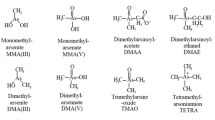Abstract
The variation of the rate of silicate uptake with varying silicate concentration in the medium was investigated in short-term experiments with the following marine diatom species:Skeletonema costatum, Thalassiosira pseudonana, T. decipiens, Ditylum brightwellii, andLicmophora sp. The uptake conformed to Michaelis-Menten kinetics only after a correction had been made for reactive silicate that apparently could not be utilized by the diatoms. The magnitude of this correction was in the range of 0.3 to 1.3 μg-at Si/l. Mean values of the half-saturation constant of silicate uptake were calculated for the different species. The lowest value was found inS. costatum (0.80 μg-at Si/l) and the highest inT. decipiens (3.37 μg-at Si/l). Growth limitation by low silicate concentrations could be a cause of species succession in marine plankton-diatom blooms.
Similar content being viewed by others
Literature Cited
Braarud, T.: A phytoplankton survey of the polluted waters of inner Oslo Fjord. Hvalråd. Skr.28, 1–142 (1945).
: On variations in form ofSceletonema costatum and their bearing on the supply of silica in cultures of diatoms. Nytt. Mag. Naturvid.86, 31–44 (1948).
Busby, W. F. and J. C. Lewin: Silicate uptake and silica shell formation by synchronously dividing cells of the diatomNavicula pelliculosa (Bréb.) Hilse. J. Phycol.3, 127–131 (1967).
Carpenter, E. J. and R. R. L. Guillard: Intraspecific differences in nitrate half-saturation constants for three species of marine phytoplankton. Ecology52, 183–185 (1971).
Darley, W. M. and B. E. Volcani: Role of silicon in diatom metabolism. A silicon requirement for deoxyribonucleic acid synthesis in the diatomCylindrotheca jusiformis Reimann and Lewin. Expl Cell Res.58, 334–342 (1969).
Dugdale, R. C.: Nutrient limitation in the sea: dynamics, identification, and significance. Limnol. Oceanogr.12, 685–695 (1967).
Eppley, R. W., R. W. Holmes and J. D. H. Strickland: Sinking rates of marine phytoplankton measured with a fluorometer. J. exp. mar. Biol. Ecol.1, 191–208 (1967).
J. N. Rogers and J. J. McCarthy: Half-saturation constants for uptake of nitrate and ammonium by marine phytoplankton. Limnol. Oceanogr.14, 912–920 (1969).
and W. H. Thomas: Comparison of half-saturation constants for growth and nitrate uptake of marine phytoplankton. J. Phycol.5, 375–379 (1969).
Guillard, R. R. L., P. Kilham and T. A. Jackson: Kinetics of silicon-limited growth in the marine diatomThalassiosira pseudonana Hasle and Heimdal (=Cyclotella nana Hustedt). J. Phycol. (In press).
Hasle, G. R. and T. J. Smayda: The annual phytoplankton cycle at Drøbak, Oslofjord. Nytt Mag. Bot.8, 53–75 (1960).
Kilham, P.: A hypothesis concerning silica and the freshwater planktonic diatoms. Limnol. Oceanogr.16, 10–18 (1971).
Kuenzler, E. J. and B. H. Ketchum: Rate of phosphorus uptake byPhaeodactylum tricornutum. Biol. Bull. mar. biol. Lab., Woods Hole123, 134–145 (1962).
Lewin, J. C.: The dissolution of silica from diatom walls. Geochim. cosmochim. Acta21, 182–198 (1961).
B. E. Reimann, W. F. Busby and B. E. Volcani: Silica shell formation in synchronously dividing diatoms.In: Cell synchrony. Studies in biosynthetic regulation, pp 169–188. Ed. by I. L. Cameron and G. M. Padilla. New York: Academic Press 1966.
Paasche, E.: Silicon and the ecology of marine plankton diatoms. I.Thalassiosira pseudonana (Cyclotella nana) grown in a chemostat with silicate as limiting nutrient. Mar. Biol.19, 117–126 (1973).
Paasche, E.: The influence of cell size on growth rate, silica content, and some other properties of four marine diatom species. Norweg. J. Bot.20, (In Press).
Sakshaug, E.: Phytoplankton investigations in Trondheimsfjord, 1963–1966. K. norske Vidensk. Selsk. Skr.1972 (1), 1–56 (1972).
Strickland, J. D. H. and T. R. Parsons: A practical handbook of seawater analysis. Bull. Fish. Res. Bd Can.167, 1–311 (1968).
Werner, D.: Die Kieselsäure im Stoffwechsel vonCyclotella cryptica Reimann, Lewin und Guillard. Arch. Mikrobiol.55, 278–308 (1966).
und A. Pirson: Über reversible Speicherung von Kieselsäure inCyclotella cryptica. Arch. Mikrobiol.57, 43–50 (1967).
Wilkinson, G. N.: Statistical estimations in enzyme kinetics. Biochem. J.80, 324–332 (1961).
Author information
Authors and Affiliations
Additional information
Communicated by B. Swedmark, Fiskebäckskil
Rights and permissions
About this article
Cite this article
Paasche, E. Silicon and the ecology of marine plankton diatoms. II. Silicate-uptake kinetics in five diatom species. Mar. Biol. 19, 262–269 (1973). https://doi.org/10.1007/BF02097147
Accepted:
Issue Date:
DOI: https://doi.org/10.1007/BF02097147




